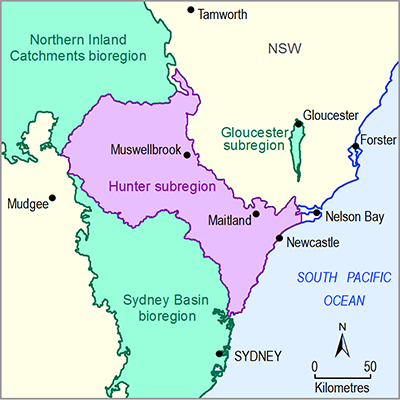BAs seek to use the best available data, given licensing and other constraints. However, even the best available data have significant constraints. The Greater Hunter mapping of vegetation (Bioregional Assessment Programme, Dataset 7) on which the mapping of GDEs is based (NSW Office of Water, Dataset 3) is a good example. A recent ground-truth study in the Upper Hunter (Hunter, 2015) found that only 7% of plant community types (PCTs) were reliably mapped. Even at the level of vegetation formation only dry sclerophyll forests and woodlands were mapped with greater than 50% accuracy. On this basis, the BA landscape classes were not defined at detailed hierarchical levels such as vegetation class or PCT. Even at the level of vegetation formation there is great uncertainty and this would have been exacerbated by attempting to deal with landscape classes at even more detailed levels.
The nature of groundwater and/or surface water dependence of much GDE vegetation is also uncertain. GDEs may occur at any position in the landscape where factors such as topography, geology and landform allow groundwater to concentrate at the surface or close enough to the surface for phreatophytic vegetation (deep-rooted vegetation that obtains a large fraction of its water needs from the saturated zone or capillary fringe) to access (Cole et al., 1997). The dependence of terrestrial vegetation on groundwater is difficult to predict or even quantify (Eamus et al., 2006). Riparian and near-riparian vegetation may have an absolute dependency on groundwater (obligate phreatophyte), whereas vegetation farther from surface expression of groundwater, where depth to groundwater is greater, may make occasional use of groundwater (facultative phreatophyte). Other vegetation may utilise local groundwater sources such as local (perched) watertables. It is possible for a vegetation community to have more than a single water dependence; for example, a community may require flooding events for seedling recruitment and survival, but be reliant on groundwater in adult life stages. Groundwater levels would be likely to fluctuate naturally as a result of climate variability and the vegetation is likely adapted to deal with this. However, rapid, large changes to groundwater levels resulting from extraction for public water supply have been shown to result in morbidity and death of GDE vegetation (Groom et al., 2000).
This uncertainty adds to the overall uncertainty regarding the impact, if any, of coal resource developments on assets such as potential habitats of threatened or endangered species and communities. Assigning such assets to landscape classes is necessarily highly uncertain due to both the high hierarchical level of the landscape classes (a species might use some vegetation within a formation as habitat but not others) and the uncertainty as to whether the vegetation formation is, in fact, present where it has been mapped. All of this is in addition to the uncertainty already associated with the potential habitat modelling undertaken by the Environmental Resources Information Network (ERIN). ERIN utilises maximum entropy (MAXENT) modelling to define the geographic extent of potential habitats based largely on physical parameters and past observations of the presence and absence of a species (Elith et al., 2011). The results of this modelling may predict potential habitat in areas where the ecosystems that support such species may not be present. Where the ecosystem, and thus the ‘potential’ habitat, is present the species itself may not be present due to many other factors, such as predation and habitat fragmentation.
There will also be great uncertainty associated with any predicted impacts on landscape classes within the ‘Riverine’ landscape group. In addition to the simplified landscape classification adopted for the BA, it is also important to note that for the purposes of a BA (where subregions or bioregions can be tens and hundreds of thousands of hectares), it is not possible to model riverine systems at the scale of pools and riffles. Even the ‘reach’ scale (1 to 3 km river lengths) is already quite detailed for a regional-scale analysis. Individual hillslope processes are not being quantitatively modelled. Changes in geomorphology that might result from coal resource development activities or remedial activities to improve geomorphology of degraded river sections are not within scope of this Assessment. This would require detailed cross-sections for river reaches in proximity to such development and remediation activities, and more detailed modelling than is currently possible. Where developments have the potential to create local-scale impacts, the acquisition of detailed riverbed cross-sections and monitoring of both geomorphology and key biological indicators such as macro-invertebrates, diatoms and water quality (Boulton et al., 2014, p. 276) should occur to track and assess such local impacts.

Product Finalisation date
- 2.3.1 Methods
- 2.3.2 Summary of key system components, processes and interactions
- 2.3.3 Ecosystems
- 2.3.4 Baseline and coal resource development pathway
- 2.3.5 Conceptual modelling of causal pathways
- Citation
- Acknowledgements
- Currency of scientific results
- Contributors to the Technical Programme
- About this technical product
